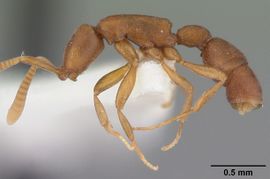Key to Oriental Probolomyrmex
This worker key is based on: Eguchi, K., Yoshimura, M. & Yamane, S. 2006. The Oriental species of the ant genus Probolomyrmex. Zootaxa 1376: 1-35.
You may also be interested in
Key Image Gallery
Eguchi et al. 2006.
1
- Petiole posterodorsally with a pair of strong angles/teeth (in dorsal or lateral view) . . . . . 2
- Petiole posterodorsally without a pair of strong angles/teeth; posterodorsal margin at most weakly emarginated medially . . . . . 3
2
return to couplet #1
- Petiole (including subpetiolar process) as long as high; subpetiolar process developed, subrectangular . . . . . Probolomyrmex bidens
- Petiole (including subpetiolar process) distinctly longer than high; subpetiolar process low, with a small anteroventral projection . . . . . Probolomyrmex procne
3
return to couplet #1
- Posterodorsal margin of petiole in dorsal view well produced medially into a horn (Fig. 8D) . . . . . Probolomyrmex watanabei
- Posterodorsal margin of petiole in dorsal view not produced (Figs. 1D, 6D, 7D), or produced but truncate or shallowly emarginate medially (Figs. 2D, 3D, 4D, 5D) . . . . . 4
4
return to couplet #3
- Posteroventral portion of subpetiolar process spinose, protruding or sharply angled (Figs. 5C, 7C) . . . . . 5
- Posteroventral portion of subpetiolar process rounded or obtusely angled (Figs. 1C, 2C, 3C, 4C, 6C) . . . . . 6
5
return to couplet #4
- Petiole in profile with its posterior outline straight and vertical (above the articulation with gaster); anteroventral projection of subpetiolar process relatively thin and Translucent (Fig. 7C) . . . . . Probolomyrmex vieti
- Petiole in profile with its posterior outline concave (above the articulation with gaster); anteroventral projection of subpetiolar process relatively thick and not translucent (Fig. 5C) . . . . . Probolomyrmex maryatiae
6
return to couplet #4
- Anteroventral portion of subpetiolar process in profile broadly expanded anteroventrad (Fig. 6C) . . . . . Probolomyrmex okinawensis
- Anteroventral portion of subpetiolar process in profile narrowly expanded anteriad or anteroventrad (Figs. 1C, 2C, 3C, 4C) . . . . . 7
7
return to couplet #6
- Petiolar node in profile with an extremely long and flattened dorsal outline (Fig. 2C); SI>160 . . . . . Probolomyrmex itoi
- Petiolar node in profile with a dorsal outline which is moderately long (or short) and flattened or curved (Figs. 1C, 3C, 4C); SI<150 . . . . . 8
8
return to couplet #7
- Posterior face of propodeum margined laterally with a carina which is angulate dorsally but only rarely forms a conspicuous propodeal spine (1C); LPtI<135 . . . . . Probolomyrmex dammermani
- Posterior face of propodeum margined laterally with a carina which forms a triangular propodeal spine (Figs. 3C, 4C); LPtI>135 . . . . . 9
9
return to couplet #8
- Frontal carina in profile lower, with a semicircular outline (Fig. 9C); 4th antennal segment a little shorter than broad (Fig. 10C) . . . . . Probolomyrmex longinodus
- Frontal carina in profile higher, with a gently triangular outline (Fig. 9D); 4th antennal segment a little longer than broad (Fig. 10D) . . . . . Probolomyrmex longiscapus

























